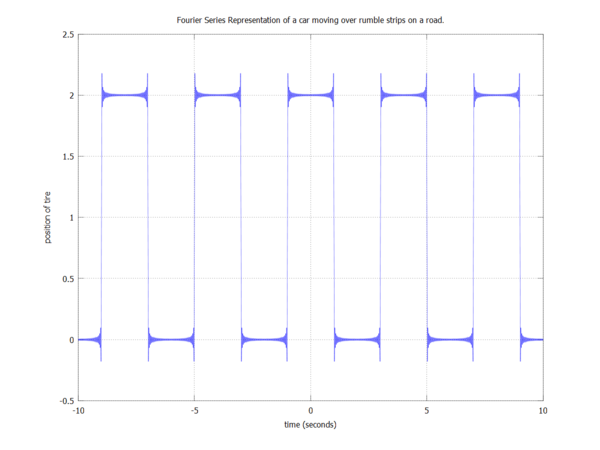Andrew Roth's Fourier Series/Laplace Transform Project: Difference between revisions
Andrew.roth (talk | contribs) (Created page with '==Problem Statement== Use a real life application of the Fourier Series or the Laplace Transform ==Solution== For my project I will plot a car's wheel running over the rumble st…') |
Andrew.roth (talk | contribs) No edit summary |
||
| Line 3: | Line 3: | ||
==Solution== |
==Solution== |
||
[[File:Squarewave.png|600px|thumb|right]] |
|||
For my project I will plot a car's wheel running over the rumble strips on the side of the road using the Fourier Transform. This will take the form of a simple square wave as the tire will fall into the dip and bump back up to the surface of the the rumble strip. The Fourier Transform may be used because the action of the car running over the rumble strips can be considered periodic. |
For my project I will plot a car's wheel running over the rumble strips on the side of the road using the Fourier Transform. This will take the form of a simple square wave as the tire will fall into the dip and bump back up to the surface of the the rumble strip. The Fourier Transform may be used because the action of the car running over the rumble strips can be considered periodic. |
||
| Line 14: | Line 15: | ||
By inspection, <math>a_0 = 1</math> and <math>T=4</math> |
|||
Also by inspection since the "wave" has even symmetry, we know that <math>b_n = 0</math> |
|||
Now we must find <math>a_n</math>. Recall that |
|||
:::<math>a_n = \frac{2}{T} \int_0^T f(t) cos(\frac{2 \pi n t}{T}) dt</math> |
|||
::::<math>= \frac{2}{T} \int_\frac{-T}{2}^\frac{T}{2} 2 cos(\frac{2 \pi n t}{T}) dt</math> |
|||
::::<math>=\frac{2}{\pi n} [sin(\frac{\pi n}{2}) - sin(\frac{- \pi n}{2})]</math> |
|||
::::<math>=\frac{4 sin(\frac{\pi n}{2})}{n \pi}</math> |
|||
So our Fourier Series is: |
|||
<math>1 + \Sigma_{n=1}^\infin [\frac{4 sin(\frac{\pi n}{2})}{n \pi} cos(\frac{2 \pi n t}{T})]</math> |
|||
==Octave Script== |
|||
clear all; |
|||
close all; |
|||
t=-10:.01:10; |
|||
T=4 |
|||
M=100 |
|||
sum1=1; |
|||
for n=1:2:M, |
|||
sum1 = sum1+(4*sin(pi*n/2)/(n*pi))*cos(2*pi*n*t/T); |
|||
end |
|||
plot(t,sum1,'b-') |
|||
title('Fourier Series Representation of a car moving over rumble strips on a road.') |
|||
xlabel('time (seconds)') |
|||
ylabel('position of tire') |
|||
grid on; |
|||
print("squarewave.png","-dpng") |
|||
Latest revision as of 22:41, 1 November 2010
Problem Statement
Use a real life application of the Fourier Series or the Laplace Transform
Solution
For my project I will plot a car's wheel running over the rumble strips on the side of the road using the Fourier Transform. This will take the form of a simple square wave as the tire will fall into the dip and bump back up to the surface of the the rumble strip. The Fourier Transform may be used because the action of the car running over the rumble strips can be considered periodic.
For simplicity. I will assume the height and width of each rumble strip is 2 inches with 2 inches gap between. I will also place the origin of the coordinate system in the middle of a rumble strip to give it even symmetry.
Recall that the equation for a Fourier Series is:
By inspection, and
Also by inspection since the "wave" has even symmetry, we know that
Now we must find . Recall that
So our Fourier Series is:
Octave Script
clear all;
close all;
t=-10:.01:10;
T=4
M=100
sum1=1;
for n=1:2:M,
sum1 = sum1+(4*sin(pi*n/2)/(n*pi))*cos(2*pi*n*t/T);
end
plot(t,sum1,'b-')
title('Fourier Series Representation of a car moving over rumble strips on a road.')
xlabel('time (seconds)')
ylabel('position of tire')
grid on;
print("squarewave.png","-dpng")

![{\displaystyle a_{0}+\Sigma _{n=1}^{\infty }[a_{n}cos({\frac {2\pi nt}{T}})+b_{n}sin({\frac {2\pi nt}{T}})]}](https://wikimedia.org/api/rest_v1/media/math/render/svg/7ff7cd7b45fdb9970b0da33c41c83b148f3066ac)






![{\displaystyle ={\frac {2}{\pi n}}[sin({\frac {\pi n}{2}})-sin({\frac {-\pi n}{2}})]}](https://wikimedia.org/api/rest_v1/media/math/render/svg/5457e60f9e4379b7e1331bb1ef9c18cb48d8f315)

![{\displaystyle 1+\Sigma _{n=1}^{\infty }[{\frac {4sin({\frac {\pi n}{2}})}{n\pi }}cos({\frac {2\pi nt}{T}})]}](https://wikimedia.org/api/rest_v1/media/math/render/svg/16ee9c8ea05255437e859852385e413e4aa8de32)